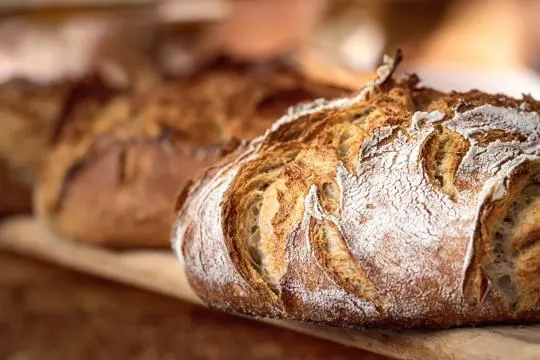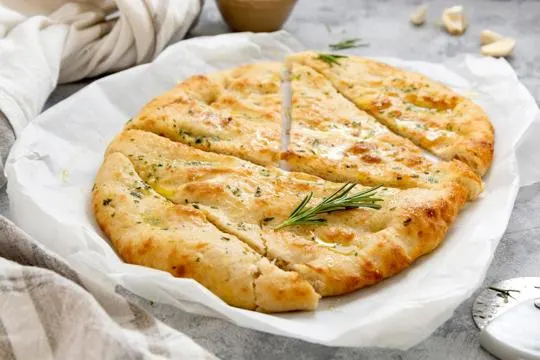Flatbread and bread share one thing: they’re both staples in diets worldwide. Yet, these two are not the same entity.
Bread comes in a dizzying array of types, each fluffy and yeast-risen. Flatbread, on the other hand, stays slim, often without yeast. Every culture has its version, from tortillas to naan.
We’ve all been there, standing in the grocery aisle, puzzled by the selection. Our kitchens have seen both, sometimes even in the same meal.
This isn’t just about what wraps your gyro or sandwiches your cheese. It’s deeper, touching on traditions and innovation in baking. This is a story of culinary evolution, a tale as old as time, yet as fresh as your morning toast.
Join the ride as we dissect these two, slice by slice.
What is Flatbread?

Flatbread is a form of unleavened bread that has been consumed by humans for centuries.
This bread is flat in appearance and is used in various culinary applications, from wraps to pizzas.
Flatbread is often made by mixing flour with water, salt, and oil, but the specific ingredients can vary depending on the recipe and cultural tradition.
What sets flatbread apart from other bread is its unique texture, making it an excellent alternative to yeast-based bread.
The lack of leavening agents means that flatbread is denser and chewier than other bread types, making it perfect for a variety of cuisines.
Overall, there are countless varieties of flatbread, each with its own distinct flavor.
Its versatility and cultural significance make it a beloved treat worldwide.
What is Bread?

Bread is a worldwide staple. It’s a baked food made from flour, water, and yeast.
Through thousands of years, bread has evolved into many flavors and types.
Bread is a main ingredient in dishes such as sandwiches, toast, and croutons.
From buns to baguettes, bread has a range of textures—crusty outside and soft inside.
Plus, bread can be enhanced with elements like seeds, herbs, or spices, making it great for traditional and innovative recipes.
It also has cultural significance – it’s featured in religious rituals and traditional celebrations.
Bread is more than sustenance; it symbolizes unity and community.
Key Differences Between Flatbread and Bread

Flatbread and bread: two distinct types of food.
Knowing the difference helps us appreciate each type of bread for its own qualities.
Ingredients Used
Flatbread and bread have similarities, yet ingredients used to make them differ.
Flatbread’s ingredients are simple, consisting of flour, water, salt, and sometimes oil.
On the contrary, bread is composed of flour, water, yeast or sourdough starter, salt, and often sugar or fat for flavor and texture.
These variations in ingredients bring about diverse tastes, textures, and culinary experiences.
Note that various flatbreads and breads come from different cultures worldwide, with their own ingredients and methods for preparation.
Leavening Agents
Leavening agents are very important for making flatbread and bread.
Yeast is a popular agent used in bread-making.
It ferments the dough to form carbon dioxide gas, making the bread light and airy.
Baking powder and baking soda are often used for leavening flatbread.
They react with acidic components and release carbon dioxide gas, causing the dough to rise.
Leavening agents give flatbread and bread their special characteristics and flavors.
Texture and Appearance
Texture and appearance are key to telling flatbread and bread apart.
Flatbread is thin, light and flexible, usually made with minimal rising agents.
It’s flatter compared to regular breads.
Meanwhile, bread has a softer, fluffier texture due to yeast or other leavening agents.
Its appearance is higher, with a more uniform shape for sandwiches and toast.
Flatbreads are thin and flexible, rolled out thinly before baking, giving them a crunchy yet bendable crust.
This texture makes them perfect for wrapping and dipping.
Bread is softer, thanks to yeast or other leavening agents.
The dough ferments, allowing it to rise and form air pockets, giving it its fluffy texture.
Appearance-wise, flatbreads are flatter and less uniform than breads.
They often have irregular edges or bubbles on the surface, which look rustic and appetizing.
Breads, however, have a higher rise and an even shape due to baking in loaf pans or shaping into rolls.
This makes them great for slicing into sandwiches or toasting.
Cultural Variations
Different cultures have their own unique ways of making and enjoying flatbread and bread.
From India’s fragrant naan to the Middle East’s fluffy pita, each region adds its own flavors and techniques.
In India, naan is popular for its soft texture and aroma.
It’s usually cooked in a clay oven called a tandoor.
Roti, on the other hand, is unleavened and made from whole wheat flour; it’s often served with curries or lentils.
The Middle East has pita – round pocket bread.
It’s often used as a utensil for scooping up dips like hummus or baba ganoush.
The dough for pita is usually made with yeast and baked at high temperatures.
In Europe, there’s the baguette. This long, slender loaf from France has a crispy crust and soft interior.
It’s great for sandwiches or savoring with cheese and wine.
Even within countries, there are regional variations.
In Italy, focaccia can have olives or onions in Liguria or tomatoes or potatoes in Puglia.
These local differences add diversity to flatbread and bread.
It’s amazing how culture plays a part in shaping our culinary traditions.
Think of the smoky flavor of Indian naan, or the airy texture of Middle Eastern pita.
Cultural variations demonstrate the world’s diversity – and how we celebrate food.
Similarities Between Flatbread and Bread

Flatbread and bread share several similarities.
Both have similar ingredients such as flour, water, yeast, and salt.
They are kneaded and shaped, then baked.
Both are staple foods in many cultures. They provide carbs and energy.
Enjoy a slice of white bread or savor a thin flatbread–both fulfill the purpose of providing sustenance.
They are also versatile. Great for sandwiches and wraps, or paired with soups, stews, and dips.
They can suit different cuisines and occasions.
Similar baking processes–shape dough, then bake at high temperatures until golden brown.
This method develops flavors and gives them an appealing look.
However, there are unique details to consider.
Pita bread has a pocket-like structure.
Traditional sliced bread is softer due to added fats or milk.
Culinary Uses and Popular Varieties
Flatbreads and breads have different culinary uses. Flatbreads are thin and unleavened.
They are perfect for making pizzas, wraps, and sandwiches.
Breads, on the other hand, come in different forms like baguettes, loaves, and buns.
They have a soft and fluffy texture.
They are great for making toast, sandwiches, and going with soups and stews.
There are many flavors and textures of bread like white and whole wheat.
Flatbreads and breads also have a special cultural significance.
Naan is very popular in Indian cuisine.
Pita bread is an important ingredient in Middle Eastern dishes, such as falafel wraps.
Sourdough bread is very popular in Europe.
Each type of bread has its own manufacturing process.
Flatbreads are made by rolling out a dough, while traditional bread involves proofing yeast.
These processes give the breads different tastes and textures.
No matter what you prefer, flatbreads and breads offer a great experience.
You can explore the world of flatbreads and breads to satisfy your taste buds.
Nutritional Differences
Flatbread and bread have nutritional variations.
Both are sources of carbohydrates, vitamins, and minerals.
Flatbread is often fewer in calories and carbohydrates because it’s thin.
But, bread may have more fiber and protein.
The ingredients and cooking methods used can influence the nutrition value.
For example, whole wheat bread has more fiber than white bread.
Conclusion
It is fascinating to learn all the diverse ways flatbreads and traditional breads have developed across the world.
From their distinct shapes, to methods of preparation, even differences in ingredients – each has something unique to offer.
While some flatbreads are more like traditional breads at their core, others scarcely resemble familiar loaves from a distance.
One thing, however, that all these breads share is our universal love of them; undying appreciation for these delicious staples of the human diet.
Steps towards understanding and appreciating the variances between flatbread and regular bread can inspire us to explore different cuisines, whether savory or sweet.
We may also reach an appreciation for process-perfecting similar recipes at home until they become our very own original works of art.

Leave a comment